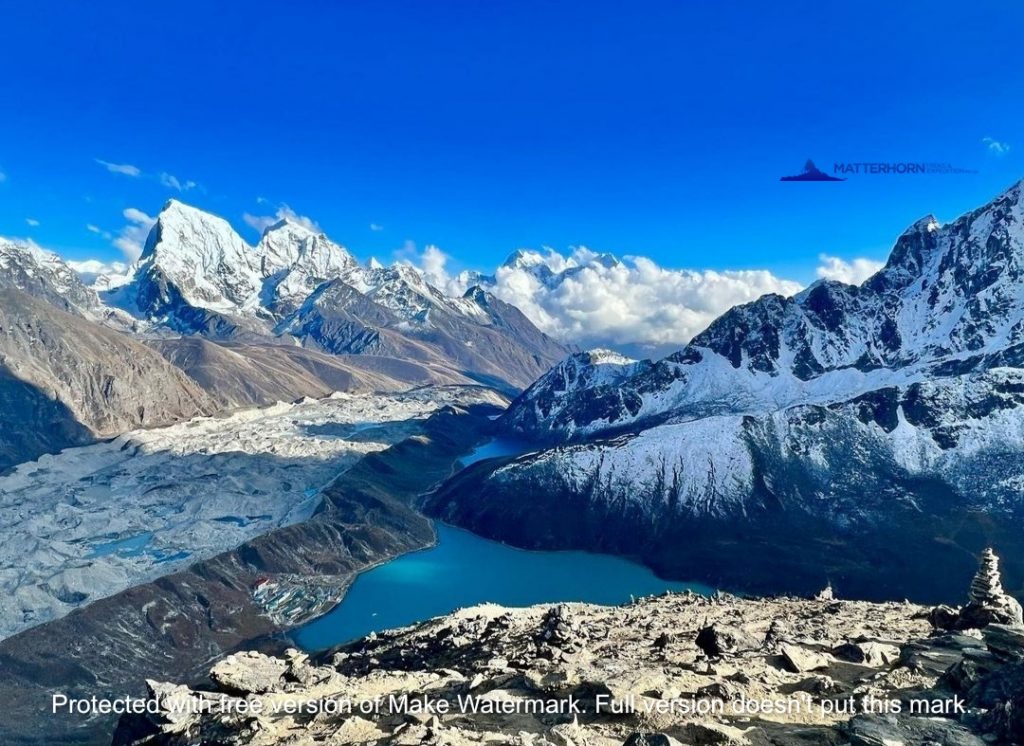Shishapangma,also called Gosainthān, is the fourteenth-highest mountain in the world and, at 8,013 m (26,289 ft), the lowest of the eight-thousanders. It was the last 8,000 metre peak to be climbed, due to its location entirely within Tibet and the restrictions on visits by foreigners to the region imposed by Tibetan and Chinese authorities.
Shishapangma is located in south-central Tibet, five kilometres from the border with Nepal. It is the only eight-thousander entirely within Chinese territory. It is also the highest peak in the Jugal Himal which is contiguous with and often considered part of Langtang Himal. The Jugal/Langtang Himal straddles the Tibet/Nepal border. Since Shishapangma is on the dry north side of the Himalayan crest and further from the lower terrain of Nepal, it has less dramatic vertical relief than most major Himalayan peaks.
There are several different theories about the meaning of the mountain’s name. Geologist Toni Hagen, who worked in Nepal for many years, explained the name as meaning a “grassy plain” or “meadow” (pangma) above a “comb” or a “range” (shisha or chisa) in the local Tibetan dialect, thereby signifying the “crest above the grassy plains”. On the other hand, Tibetologist Guntram Hazod records a local story that explains the mountain’s name in terms of its literal meaning in the Standard Tibetan language: shisha, which means “meat of an animal that died of natural causes”; and sbangma which means “malt dregs left over from brewing beer”. According to the story, one year a heavy snowfall killed most of the animals at pasture, and all that the people living near the mountain had to eat was the meat of the dead animals and the malt dregs left over from brewing beer, and so the mountain was named Shisha Pangma (shisha sbangma), signifiying “meat of dead animals and malty dregs”. The Sanskrit name of the mountain, Gosainthan, means “place of the saint” or “Abode of God”.
Day 01 Arrival in Kathmandu
Arrival in Kathmandu Tribhuvan International Airport, a representative from Matterhorn Treks & Expedition will transfer to your hotel, We will briefed about your trip activities. You’ll have rest of the day at leisure.
Overnight at Hotel B/B.
Day 02 Kathmandu Sightseeing
Sightseeing in Some of landmarks that are the World Heritage Sites of Kathmandu Durbar Square, the sacred Hindu temple of Pashupati Nath, the famous ‘Monkey Temple’ (Swayambhu Nath) and Buddhists shrine (Bouddha Nath). You can also make your last minute buying of personal items and preparation for the next day.
Overnight at Hotel B/B.
Day 03 Preparation day in Kathmandu for Shishapangma Expedition
Overnight at Hotel B/B.
Day 04 Drive to Zangmu (2300m)
Overnight in hotel.
Day 05 Drive to Nyalam (3750m)
Overnight in hotel.
Day 06 – 07 Nyalam, acclimatization days
Day 08 Drive to Base Camp (4700m)
Day 09 – 11 Stay at Base Camp
Day 12 Advanced Base Camp (5600m)
Day 13 Advance Base Camp
Day 14 – 38 Climbing Period
Day 39 Return to Advanced Base Camp
Day 40 Return to Base Camp
Day 41 Stay at Base Camp
Day 42 Clean up Base Camp
Day 43 Drive to Zangmu
Overnight in hotel.
Day 44 Drive back to Kathmandu
Overnight at Hotel B/B.
Day 45 Free day in Kathmandu for independent activities
Overnight at Hotel B/B.
Day 46 Kathmandu
This pleasant day you may have full day at leisure at your own or can be extends your extra trip with us on additional cost or time to explore the Thamel for last day shopping and evening Matterhorn Treks & Expedition will take you for Farewell dinner.
Overnight at Hotel B/B.
Day 47 Departure from Kathmandu
Matterhorn treks & Expedition will transferred to the International Airport your departure flight to your onwards destination.
Fill up the form below to tell us what you're looking for

